Fighters
The Sea Gladiator had been the main fighter for the Fleet Air Arm 1934 to 1938, and only a few squadrons were left in service by the time World War Two started.
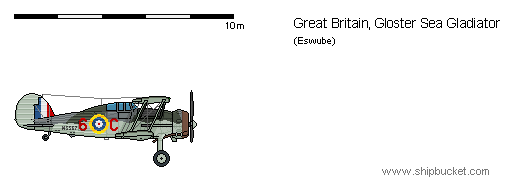
Fleet Air Arm (1938-1945)
Back to Commonwealth Ships
List.
1919 and the Royal Flying Corps and the Naval Air Service are
joined together and called the Royal Air Force. It wasn't till 1924 that the
Navy got a branch of its own to fly the aircraft from the carriers and defend
its shore facilities. But... and its a big but - all the aircraft for the Navy
were chosen for it by the Air Force. This made sure that the Naval Service had
second class aircraft, right through till mid-1939 when the Navy finally
regained control of its air service to create the Fleet Air Arm. In real life
this meant that the Navy had, on the outbreak of war, the Fairey Swordfish as
its main strike aircraft, the Gloster Gladiator as a fighter and the Blackburn
Skua as a fighter/dive bomber. All were totally outclassed by their opposition.
That they did as well as they did, in time of war, was as much to the courage of
the pilots as anything else. That does not suit me too much so I give the Fleet
Air Arm back to the Navy in 1930. That allows the Navy to commission its own
aircraft from that point onwards. By 1939 the shape of the Fleet Air Arm is much
different.
Fighters
The Sea Gladiator had been the main fighter for the Fleet Air Arm 1934 to 1938,
and only a few squadrons were left in service by the time World War Two started.

General characteristics
Performance
Armament
Four .303 calibre M1919 Browning machine guns; two synchronised
guns in fuselage sides and one beneath each lower wing.
The Gladiator was replaced in service by another Gloster aircraft that had
started life as specification F5-34 and was called the Griffon by Gloster. This
was the first all metal monoplane for the Fleet Air Arm. The Griffon entered
service in 1937 and was a contemporary of the Hawker Hurricane. The Gloster
Griffon gave the Fleet Air Arm a fighter equal to any in the world at the time.
Its great power to weight ratio meant it could fly off all of the carriers, even
the baby escort carriers. Production went through to 1943 and the Griffon
probably served on all of the RN's carrier fleet. Various upgrades were given,
the major one being to increase the engine power from the original 1000hp out to
1200hp with an increase in speed from 345mph to 365mph.
.png)

The Gloster Griffon served everywhere and proved a handful for the Me109's and
Japanese Zeros. It outperformed the lesser Italian aircraft.
General characteristics
Performance
Armament
Guns: Eight 0.303-in (7.7-mm) Browning machine guns (1937-41)
from 1941, four x 20mm Hispano cannons.

Mk-1 Gloster Griffon with eight gun wings.
While Gloster was producing the Griffon as fast as it could, the demand for
aircraft for both the aircraft carrier squadrons and the naval installations
(ports etc) outstripped production. The Royal navy at that time (1940) took over
an order for Grumman Wildcat fighters for France, that were no longer able to be
delivered due to the Fall of France in July 1940. The RN took those 200 aircraft
and ordered a further 200 from Grumman. In RN service this fighter was called
the Martlet. It proved a very sturdy aircraft and mainly operated off the
smaller CVL and CVE types. With the Martlets the Royal Navy ordered a navalised
version of the Hawker Hurricane (Sea Hurricane). The RAF had no problem in
letting Hawker produce the Sea Hurricane from the older Mk-1A/B Hurricanes which
were being phased out of RAF service in favour of the C and D models with the
uprated engines and armaments.

General characteristics
Performance
Armament
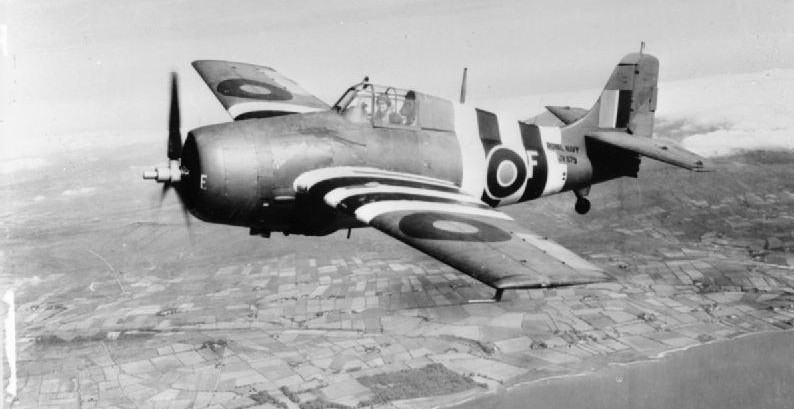

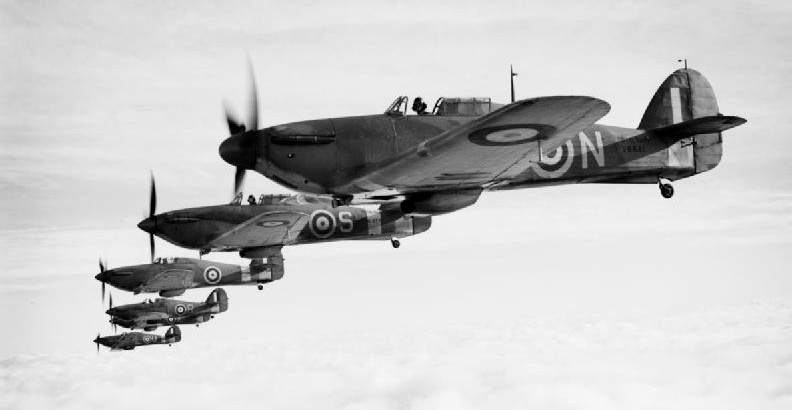
Probably the most interesting design, and the only twin engined fighter for the
RAN till the De Havilland Sea Hornet of 1945-46, was the development of the Mk-2
Westland Whirlwind. This work was done in Australis by the CAC factory to
improve the Mk-I Whirlwind to a navalised, long range, fighter able to operate
from the Australis Endeavour Class aircraft carriers and later the RN's
Illustrious class aircraft carriers when they started working in the Pacific.
What they came up with was (to my eyes anyway) one of nicest looking aircraft of
the time. The Whirlwind Mk-2 was introduced into service in October 1941 and
enough were released to the first two Endeavour class carriers to make the
difference in the evacuation of Singapore in early 1942.

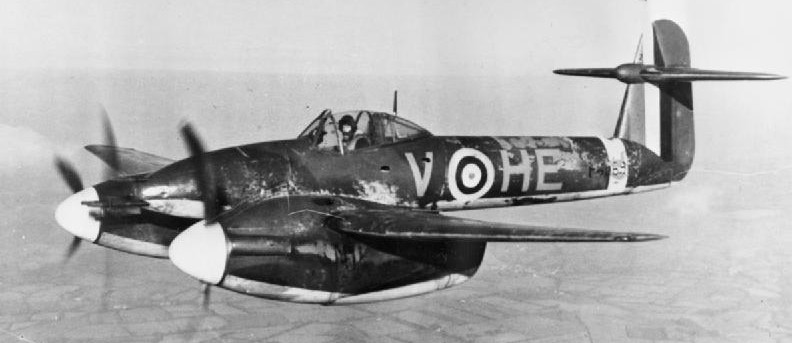
Photo is of a Mk-1 which shows the differences between the 1 and 2. Cockpit
forward, Merlins replace Peregrines.
General characteristics
Performance
Armament
From 1943 the Gloster Griffon was at the edge of its upgrade limits. It needed
to be replaced. Gloster had nothing in the pipeline as a replacement, but Hawker
and CAC both had aircraft that would make admirable replacements of the
venerable Griffon. Hawker offered the RN a navalised version of the new Tempest
design which they called the Sea Fury. The CAC had a new design Ca-15 Kangaroo.
Also with the two home grown fighters, orders of the American F4U - Corsair
aircraft started arriving and being loaded aboard the big carriers. The Griffon
remained in service on the smaller carriers (CVE and CVL) that were unable to
operate the big new fighters.

General characteristics
Performance
Armament
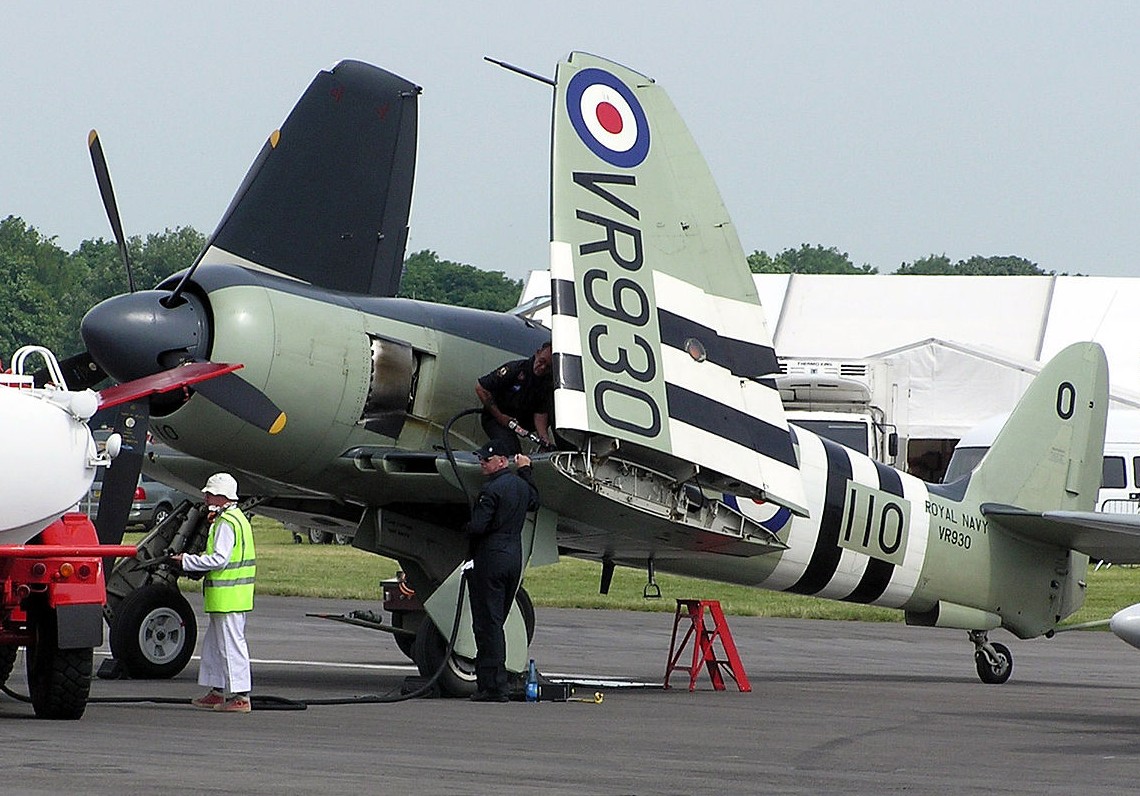
The CA-15 Kangaroo was the Australis Navies answer to replacing the near
obsolete Gloster Griffon Fighters.

General characteristics
Performance
Armament

The Corsair was a big powerful aircraft, that for some reason was not liked as
much by the USN as it was by the RN.

General characteristics
Performance
Armament
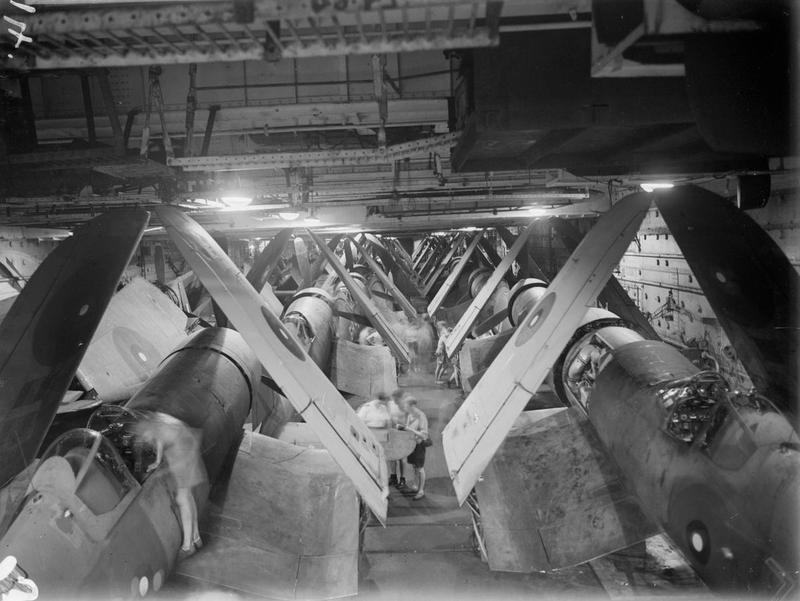
The last fighter that made it into service before the end of the war was the de
Havilland Sea Hornet. This was a magnificent aircraft and was the fastest piston
engined fighter of its time, it was an advance on the previous Mosquito and took
that type to the next level.. An
aim for the aircraft was to conduct long range fighter operations in the
Pacific Theatre
against the Empire of Japan.
While it conducted the same duties as the Whirlwind 2, the Hornet was just a
better all round aircraft and replaced the Whirlwind in service. Where the Sea
Hornet also excelled was as a nightfighter. Room was made in the fuselage for a
radar operator. While doing this page I would note that in 10 years from the Sea
Gladiator of 1935 with a maximum speed of 253mph the Fleet Air Arm had the Sea
Hornet, which cruised at 270mph and a maximum speed 200mph faster. War really
does compress technology advances.
General characteristics
Performance
Armament
Avionics
ASH radar fitted in Sea Hornet NF Mk 21.
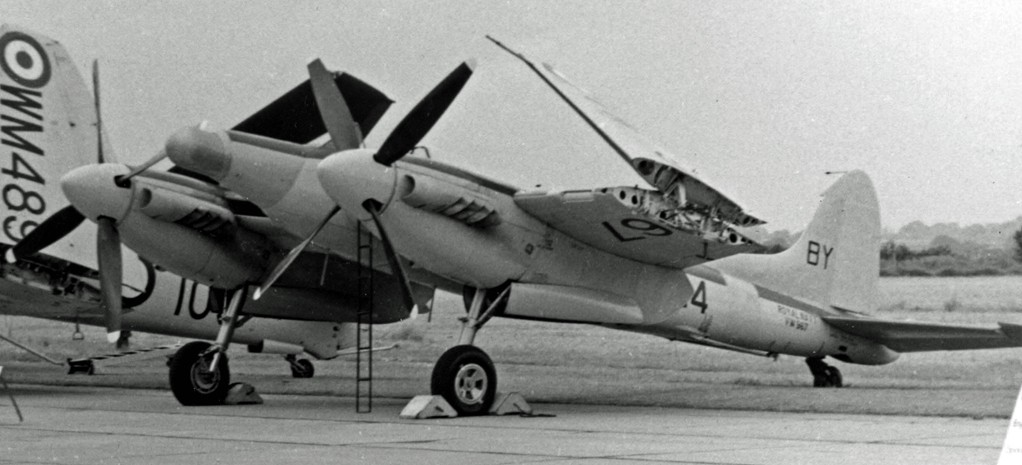
Sea Hornet Night fighter with radar in the nose.
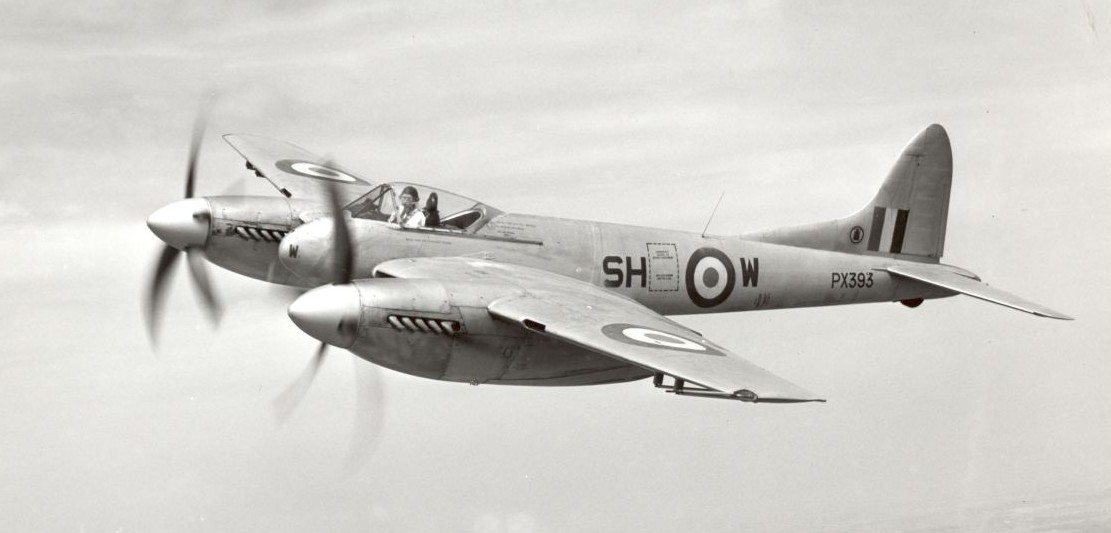
Hornet in flight showing off the beautiful lines of the type.
Dive Bombers:
Only one real type of dive bomber served the Royal Navy in the Second World War,
and that was the Blackburn Skua.
The
Blackburn B-24 Skua
(O.27/34)
was a carrier-based
low-wing, two-seater, single-radial engine
aircraft operated by the British
Fleet Air Arm. Originally the aircraft was to have dual functions of both
dive-bomber and fighter. The acceptance of the Gloster Griffon (F5/34) as the
Navies fighter, meant that the Skua only had to concentrate on its dive bomber
function. To simplify logistics aboard ship, both the Skua and Griffon shared
the same power plant. It was felt by the Navy that the slow, 260mph, speed of
the Skua made it obsolete from about 1940-41 and the Navy had phased out the
Skua by the end of 1941 aboard the front line carriers. There was no replacement
for the Skua until the introduction of the Fairey Spearfish (1945) which was
supposed to be a Torpedo/Dive bomber, the RN doing its usual trick of trying to
get one aircraft to do more than one job - usually poorly. This compares to the
Ju-87 Stuka which soldiered on right through to the end of the war despite that
aircraft being obsolete from about 1940. Both the Japanese and United States
both used dive bombers right through the war, upgrading the different types with
new aircraft as necessary. Why? Because the dive bomber was a precision attack
aircraft. Bombers tend to 'spray' their bombs in the hope that one to some may
land on the target. Something the Royal Navy missed.
In my AU world the Skua lasts through to the end of 1943, with the same uprated
engines (to 1200hp) being fitted as the Griffon, both types resulting from 1934
specifications being phased out at the same time. So the time between the Skua
and the Spearfish is kept down to as short a time as possible.
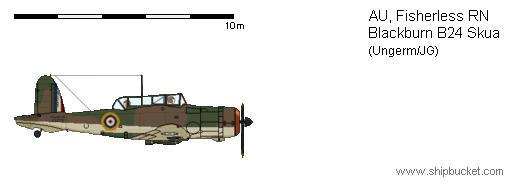
General characteristics
Performance
Armament
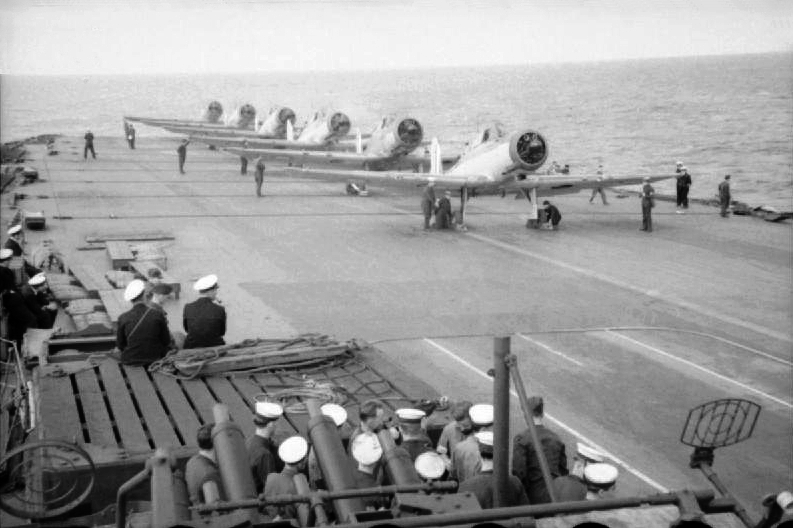
Half a squadron of Skuas readying for launch off an Ark Royal Class aircraft
carrier.

Bombers:
At the start of World War Two, the main bomber aboard the RN carriers was the
Fairey Sea Battle. However the obsolescent Fairey Swordfish was still being used
aboard the smaller CVE and CVL type carriers that were just not big enough to
launch and recover the big Sea Battles. The Sea Battle force was greatly
enlarged after 1940 by the navalisation of the remaining RAF Battle aircraft
after the type had proved to be sitting ducks for the Me-109 and even Me-110
fighters. The Battle was supposed to be a 'day' bomber that could always make it
through. The Maastricht Bridges proved that one to be false. Out at sea where
there was less chance of being intercepted without fighter cover was much less,
the Sea Battle proved to be a winner. The Swordfish also proved to be durable
and was used aboard the CVE's in the North Atlantic and elsewhere throughout the
war. not being replaced in service till enough Grumman Avengers were received to
replace not only the Swordfish but the Sea Battle as well. Lastly in late 1944
early 1945 the Fairey Spearfish made it into service.
The Allied navies never had enough aircraft carriers (even with my AU help) so
that the small CVE's and CVL's were drafted in to battles to act as air support
carriers. In real life the most famous of these battles is at Salerno and Anzio
where no large fleet carriers were available and the support was provided by
CVE's trying to operate high speed Seafires. It ended up with more Seafires
being lost during the war to 'accidental' causes than enemy action.
By the end of the war, the Swordfish held the distinction of having caused the
destruction of a greater tonnage of Axis
shipping than any other Allied aircraft.
The Swordfish remained in front-line service until V-E Day,
having outlived multiple aircraft that had been intended to replace it in
service.

General characteristics
Performance
Armament
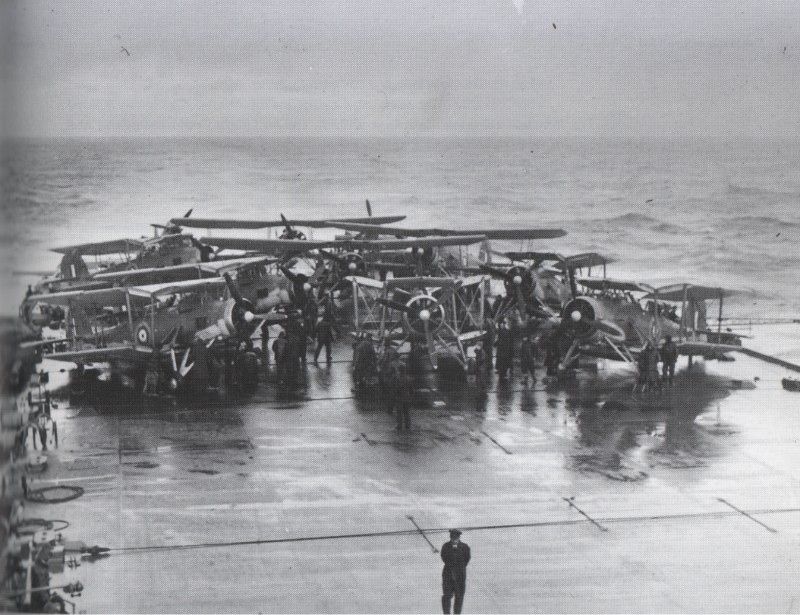
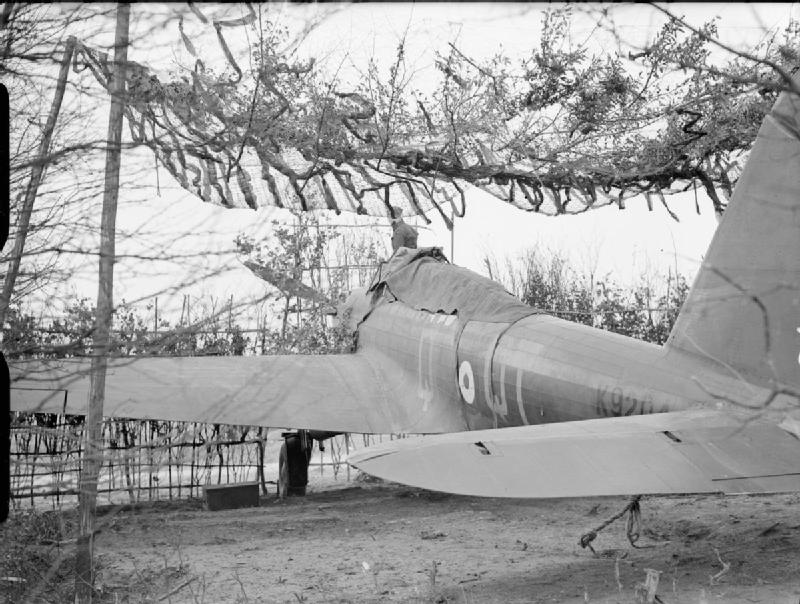
Royal Air Force Battle in France 1939. Within twelve months the same aircraft
would be flying off an aircraft carrier.
Probably the most important aircraft the RN Fleet Air Arm sourced from America
was the Grumman TBF Avenger. A big, robust aircraft, it had the good manners to
be able to be operated from even the smallest CVE's, something the Sea battle
was never quite able to do. As stated for the Swordfish, the RN actually started
replacing the Sea Battle on the main Fleet Carriers long before the Escort
Carriers in RN service got a chance to have them aboard.

General characteristics
Performance
Armament
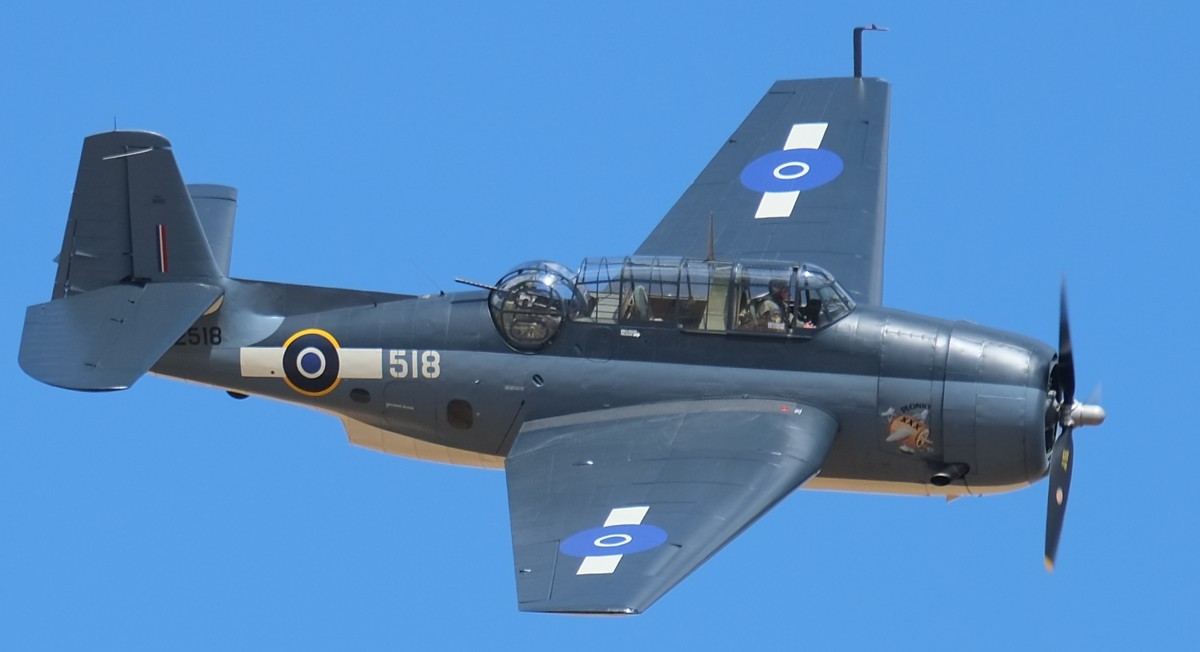
The
Fairey Spearfish
was a British carrier-based,
single-engined, torpedo bomber/dive
bomber
that was ordered from Fairey Aviation
for the Fleet Air Arm
during World War II.
Designed during the war, the prototype did not fly until July 1945. Much larger
than earlier naval bombers, it was designed for use aboard the large
Malta-class
aircraft carriers that were cancelled after the war and was itself cancelled
thereafter. Seven prototypes were ordered, but only five were built, of which
four actually flew. They were mostly used for experimental work until the last
aircraft was scrapped in 1952. Don't you just hate real life. For my AU
purposes, the Spearfish flies in 1944 and is rushed into service aboard my
large
carriers as they head for the Pacific in 1945.

General characteristics
Performance
Armament
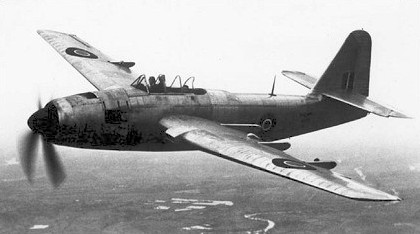
Other bomber aircraft that just missed the war but owed its design to WW2, was
the Fairey Gannet that provided sterling service as the Navies first true ASW
aircraft are worth a small mention, and because I just happen to have an FD
scale drawing handy. That it was capable of carrying a small nuclear device did
not hurt either.

Miscellaneous Aircraft:
Lots of aircraft fall into this category as the Navy was like any other service
and grabbed whatever it could to fill a particular need at the time. This goes
as much for frontline aircraft like the Grumman Martlet and Fairey battle. Mana
from heaven comes in many shapes and sizes. Most of the miscellaneous aircraft
here will be about the seaplane / floatplanes / amphibians that were carried
aboard the major warships of the Navy. The many different types of transport
planes etc used by the Navy are outside the scope of what I want to do with this
site. Aircraft like the Sunderland and Catalina were operated by Coastal Command
a division of the RAF but were often based at Royal Navy bases or Area Defense
Vessel's at overseas stations.

The Shark was obsolete by the start of WW2 but like a lot of Fleet Air Arm
aircraft the Shark just had to soldier on till it could be replaced by either
Swordfish floatplanes or Walrus amphibians.

The Swordfish, Walrus and Seafox were the standard shipborne aircraft on the
cruisers and capital ships. Where they also proved more than useful was on the
ADV's for coastal patrols.

The Walrus was probably the best of the non-carrier borne aircraft and was
useful for local ASW patrols. Any escort ship to the convoys that could launch
aircraft was a great help. At least until there were enough escort carriers to
go around.

Mainly used aboard the early 1930's light cruisers, with one or two notable
exceptions. The bottom right shows the Seafox placed aboard HMS Asturias.
Asturias was sent to the Newport News shipyard in America to be refitted. An
aircraft hangar and catapult were installed, which necessitated the removal of
the mainmast and the after part of the superstructure, and new guns were fitted.
Early in 1942, Asturias returned to service, being sent to Freetown to patrol in
the South Atlantic. Asturias being an armed merchant cruiser, and was also used
on the convoy routes between Southern Africa and Sierra Leone.

The Kingfisher started being sourced from the USN in 1942 as a patrol aircraft
launched from cruisers. (See
Enterprise)
The first
jet to enter RN service was the Vampire, though the first jet trials were with
the Gloster Meteor.

NOTE: the "General Characteristics" have been sourced from Wikipaedia, but
often the stats have been altered to fall in with some idea of mine for the AU
they may be in.